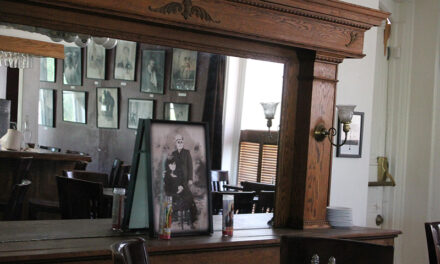BOSQUE FARMS — Impressive properties dot the landscape in Bosque Farms, some featuring cute homes and exquisite haciendas.
For many passersby, the homes that truly standout are not grandiose, but small, box-shaped residences that are a significant part of local history.
These are the Depression-era — or Dust Bowl homes — of the 1930s. Both names conjure up images of hard times and hardy souls. In many ways, the rise of these adobe structures started the modern-era of Bosque Farms, which was incorporated about 40 years later in 1974.
As detailed in “Mountains, Mesas & Memories” by local historians and authors, Richard Melzer and John Taylor, the land was cleared and 42 homes built as part of President Franklin Roosevelt’s New Deal to resettle farmers during the Great Depression.
Many of those residents, some from Harding and Taos counties, soon moved on because of the poor quality of the soil, leaving the houses behind. One estimate is that about a dozen of the original homes are still standing.

Mike Powers| News-Bulletin photos
One of the original Depression-era homes in Bosque Farms was recently demolished to make room for a development.
Joe and Joann Arvizu are the third owners of one such home on South Bosque Loop. The house, built in 1933, “overtook my essence,” Joann says.
Getting Joe on board was a tougher task.
“I was attracted to this house, but it drove him crazy,” Joann said.
Joe’s response?
“I was reluctant, but I knew where she was going with it,” Joe said.
In 1992, the Arvizu’s bought the home “as is,” and have kept it mostly “as was,” with few changes. Joann points out the bed, bathtub and windows are all original in the seven-room house. Other reminders of the past include an old fashion ice box, an original water trough and remnants uncovered outside over the years, such as railroad ties, spikes, marbles, license plates and a silver buckle.
After “lots of paperwork,” the state of New Mexico listed the home on its historical registry. The most difficult part of the process was getting approval for alterations to the roof.
“It was a dirt roof,” Joe said, making it heavy and uninsurable. “She (Joann) wanted to leave it that way. There was grass growing on it.”
With the approval of an architect with the state, appropriate changes were made.
The Arvizu “homestead” is two acres, much smaller than the parcel the Jackson family, the first occupants, called home.
“Everything here is personal. There is so much history,” Joann beamed as the couple sat last month in their striking dining/living room.

Joe and Joann Arvizu love the Bosque Farms Depression-era home they have lived in since 1992.

Local historian Kathryn Roberts, who recently led a discussion on the history of Bosque Farms, would like to see depression era homes preserved.
About a mile away on Bosque Farms Boulevard, George Hobbes reflects on his Depression-era home, which is no longer a home in the traditional sense.
For about 35 years, this building has been “home” to Hobbes Accounting.
Hobbes says it was his late wife, Martha, who wanted an adobe home.
“She was interested in ‘antiquity,’” Hobbes chuckled, so they compromised on an adobe structure for his business.
The exterior hasn’t changed much, but the same can’t be said for the interior.
“It’s not an easy building to convert into an office, but over the years, you adapt,” Hobbes said.
One bedroom is now a bathroom, another is the reception area.
Like the Arvizu’s, Hobbes needed a new roof, settling on one made of tar and gravel.
“That was a mistake,” he said. “There was no insulation. The first summer was miserable.”
One thing that hasn’t changed is the trademark vigas, the wooden beams that adorn the ceiling. Hobbes was once told by a client, George Sichler, that in the 1930s Sichler was hired to haul the vigas from the Manzano Mountains.
Teresa Sichler Chavez says in Sichler family lore, brothers George, Andrew and Ernest, her grandfather, all helped move the vigas to Bosque Farms.
“They had a truck just for that,” Chavez said, adding that she was told George was only 14 years old when he would drive loads from the mountain to the valley.
Joann Blystone has bittersweet memories of growing up next to a Depression-era home, which she remembered as the “Woodall Place,” located on what is now the Growers Market in Bosque Farms.
“Everybody that lived there loved it,” Blystone recalled. She would play at the house with friends. “It turned into a rental property and it was just one family after another. They absolutely loved it, and had big plans for it. The money would run out and they would be gone.”
As an adult, Blystone’s memory turned from sweet to bitter.

George Hobbes has operated his accounting business out of a Depression-era home for about 35 years.

Bosque Farms Depression-era homes were originally built to resettle farmers impacted by the Dust Bowl.
“To my horror, one day I went by there and it was gone,” the old adobe demolished. She later visited the site. “It brought a tear to my eye. I picked up some of the rubble and brought it home because it was part of the old home.”
Blystone says also gone were an old road, a milk barn and a garage that once housed a classic car.
“What happened to the Pierce Arrow?” Blystone wondered, about the vintage vehicle she and friends would play around during their youth.
Others were dismayed in July when another of the original 42 homes, located on Bosque Farms Boulevard, was cleared out to make way for a commercial development. For 10 days, all that remained was the front of the home, with a “welcome” sign above the door and two trees seemingly standing as sentries. Soon, they were gone as well.
For some in Bosque Farms, these homes are like family.
“I bawled like a baby,” was the reaction of Joann Arvizu after she saw what was left of the house.
“When I retire, I’ll sell the place for whatever I can get for it,” said Hobbes, but it won’t go to anyone who will tear it down.
Village planning and zoning administrator Michael Montoya told the News-Bulletin there are no codes or village ordinances protecting the Depression-era structures.
“I was almost angry when they tore down that house,” said local historian Kathryn Roberts said.
Roberts would like the village of Bosque Farms to buy one of these homes and turn it into a museum, and “Preserve as many as they can. I hope they do — even if they rent them to people.”
After a recent discussion about her book “Los Pinos to Bosque Farms,” Roberts reflected on the quality of the adobe homes, which had dirt floors and specifications from two different floor plans.
“It surprises me that they knew how to do that,” Roberts said of the mostly untrained young workers responsible for the labor.
Both Joann Arvizu and George Hobbes can attest to the craftsmanship, calling the homes, “solid” and “sturdy.” However, while Arvizu praises her home for a low heating bill and being comfortable all year round, Hobbes sees it differently.
Hobbes says the reputation of adobe homes being warm in the winter and cool in the summer is overstated.
“This summer I’m running all three of them,” he said, referring to fans placed around the office.
Arvizu acknowledges several cracks in the wall of her home, but, “they mean something to me.” She is often asked why she doesn’t want a more up-to-date home.
“I had modern,” she said. “It didn’t have the warmth. This house has warmth — they will have to carry me out of here.”
Mike Powers spent more than 40 years as a television news and sports anchor, mostly in the Albuquerque market. He has won numerous awards including New Mexico Sportscaster of the Year. He covers a wide range of sports, including the Valencia County prep scene.


















